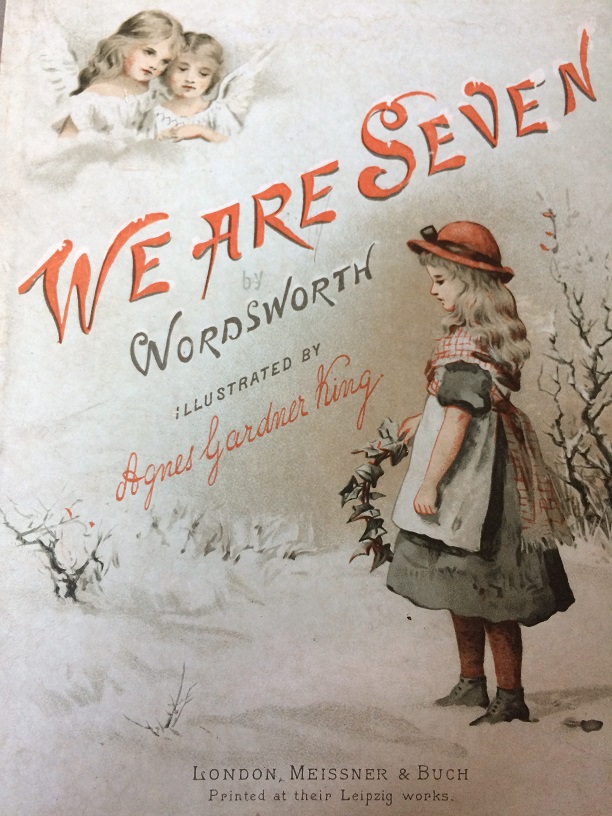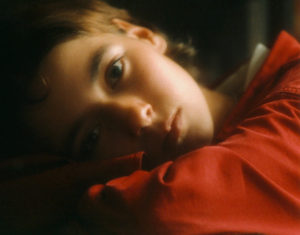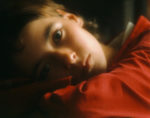
William Wordsworth (b. 7 April 1770, d. 23 April 1850) and Samuel Taylor Coleridge (b. 21 October 1772, d. 25 July 1834) are major English Romantic poets. In 1798 they published together the collection Lyrical Ballads, With a Few Other Poems, which helped to launch the Romantic Age in English literature. A well-known poem in that collection is the 10th, written by Wordsworth (except perhaps the first stanza written by Coleridge), titled “We are Seven.”
A little girl enumerates her brothers and sisters, and considers the two dead ones as still being with the family, as their grave indicates their presence.
WE ARE SEVEN.
A simple child, dear brother Jim,
That lightly draws its breath,
And feels its life in every limb,
What should it know of death?
I met a little cottage girl,
She was eight years old, she said;
Her hair was thick with many a curl
That cluster’d round her head.
She had a rustic, woodland air,
And she was wildly clad;
Her eyes were fair, and very fair,
—Her beauty made me glad.
“Sisters and brothers, little maid,
“How many may you be?”
“How many? seven in all,” she said,
And wondering looked at me.
“And where are they, I pray you tell?”
She answered, “Seven are we,
“And two of us at Conway dwell,
“And two are gone to sea.
“Two of us in the church-yard lie,
“My sister and my brother,
“And in the church-yard cottage, I
“Dwell near them with my mother.”
“You say that two at Conway dwell,
“And two are gone to sea,
“Yet you are seven; I pray you tell
“Sweet Maid, how this may be?”
Then did the little Maid reply,
“Seven boys and girls are we;
“Two of us in the church-yard lie,
“Beneath the church-yard tree.”
“You run about, my little maid,
“Your limbs they are alive;
“If two are in the church-yard laid,
“Then ye are only five.”
“Their graves are green, they may be seen,”
The little Maid replied,
“Twelve steps or more from my mother’s door,
“And they are side by side.
“My stockings there I often knit,
“My ‘kerchief there I hem;
“And there upon the ground I sit—
“I sit and sing to them.
“And often after sunset, Sir,
“When it is light and fair,
“I take my little porringer,
“And eat my supper there.
“The first that died was little Jane;
“In bed she moaning lay,
“Till God released her of her pain,
“And then she went away.
“So in the church-yard she was laid,
“And all the summer dry,
“Together round her grave we played,
“My brother John and I.
“And when the ground was white with snow,
“And I could run and slide,
“My brother John was forced to go,
“And he lies by her side.”
“How many are you then,” said I,
“If they two are in Heaven?”
The little Maiden did reply,
“O Master! we are seven.”
“But they are dead; those two are dead!
“Their spirits are in heaven!”
‘Twas throwing words away; for still
The little Maid would have her will,
And said, “Nay, we are seven!”
This poem was adapted in French, rather faithfully, by Jean Aicard, with the translated title “Nous sommes sept.”
Although Wordsworth said that the poem was inspired to him by his meeting with a little girl near Goodrich Castle (in England), the town of Conwy, Caernarfonshire, North Wales, claims to have the tomb mentioned in the poem lying in the churchyard of the St Mary and All Saints Church. Valérie Lewis, a local guide, communicated me the following photograph:

This photograph and 3 others can be found in the Old UK Photos website, on the 6 pages devoted to Old Photos of Conwy in Caernarfonshire.
Source of the poem: Lyrical Ballads, With a Few Other Poems, Project Gutenberg Ebook (HTML version); also available on Wikisource and at The Literature Network.
This is a revised version of a post previously published on Agapeta, 2015/08/19.

